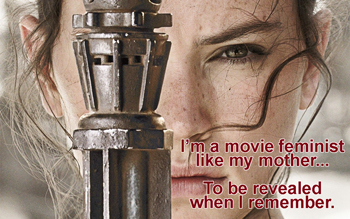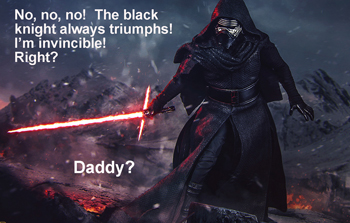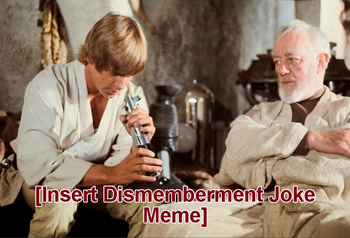I took a bit of flak for my Facebook post saying that Star Wars: The Force Awakens (SW:FA) “was the sequel we’re looking for.”
Look, it had the spectacle we wanted, the Millennium Falcon in a tight dogfight on the planet, the new bad guy with a western laser sword, the rogue Han Solo back in the saddle with a young audience to remind and expand that beloved arena we missed, without regard for those horrid prequels.
But no, it’s not all I ever wanted. The story has character issues. It has story issues as well (cough, retread), but as a long prologue to a larger epic, it’s not a bad start.
Before I begin, let me state that no, the Force has not change my life. No, I do NOT believe the Empire Strikes Back is the greatest movie of all time. I prefer other stories and have other interests, so my expectations for this new saga were not that high.
But Star Wars is a cultural phenomenon so we shouldn’t miss it. That said, if Lucas asked me to write a follow up on a billion dollar franchise, I might have done things a lot differently…
Finn from central type-casting
One of CNN’s talking heads called the original Star Wars racist because Vader was a black James Earl Jones until he returned to the light side of the force and became a venerable white man.
But in SW:FA, surprise! The universe does have black guys. They’re just trapped in white shells, bred and trained to slavishly serve their white oppressors.
Wow, ugly culture turn, huh? Kind of makes that “Jedi mind trick, influence on weak minds” thing a bit racist too, doesn’t it?
In screenwriting, we’re supposed to develop both character and important characterizations, take them through a journey of transformation, and THEN decide what race or gender to apply.
 SW:FA did none of that. Finn is yet another modern black stereotype: the nice jock character. He seems borrowed from an inspirational sports movie (Cuba Gooding Jr, we’re looking at you!) to be the sensitive and funny boyfriend. Yes, it’s better than the wise-cracking, street-smart cop character (surrounded by a bunch of white incompetents). And we should be thankful they didn’t go full Bagger Vance on us (too many of those already in the saga).
SW:FA did none of that. Finn is yet another modern black stereotype: the nice jock character. He seems borrowed from an inspirational sports movie (Cuba Gooding Jr, we’re looking at you!) to be the sensitive and funny boyfriend. Yes, it’s better than the wise-cracking, street-smart cop character (surrounded by a bunch of white incompetents). And we should be thankful they didn’t go full Bagger Vance on us (too many of those already in the saga).
In New Hope, we liked the simplicity of the faceless minions of the empire battling our Hero With a Thousand Faces characters in a space opera about a country boy who becomes a Jedi master and saves the galaxy.
But Finn is a lost soul defying his warrior culture to become a citizen of the galaxy again (like Jason Bourne or Wolverine?). And actually, that’s not so bad except that again, Finn becomes the “nice jock.” I’d like him to be different in two ways:
- More effective as a soldier. Why would he run from Rey when she first sees him? And then what’s with the hand holding? I want less of a protective older brother on the playground routine, and more of a trained mercenary, capable of a tactical retreat and improvised weapons.
- Less insta-boyfriend. Again, he’s a trained mercenary from birth. Like a former Ugandan child soldier, he has no frame of reference for almost every human interaction or cultural norm away from his chain of command. That makes his transition to regular human potentially interesting to watch. If he’s running with Rey, the first beautiful woman he’s ever set eyes on, he may be evolving quickly but clumsily. And as a former soldier, he’ll have lapses, with roughness and sentimentality in the wrong places. These flipped expectations are what made Butch Cassidy and the Sundance Kid so entertaining.
Finn should be the stoic one who goes on a journey toward his humanity in the sequels.
Rey as Feminist Myth
Consider for a moment that in New Hope, our hero Luke is the whiny farm boy who stumbled onto a droid, then got beaten up by Jawas, humiliated in a bar, led around by the nose by an old codger while being teased by the cool smuggler and his walking carpet. His rescue plan bombed and he almost drowned in a garbage compactor, then he narrowly escaped thanks to the codger sacrificing himself (and then yelling at him from the dead to get his butt in gear), and finished his mission through continued haunt motivation all while squealing “I did it” like a little girl.
 Rey, on the other hand, is a fully-formed warrior chick ready for her Yoda to complete her training. She’s intuitive, a better fighter than any four guys (or black storm trooper) twice her size, able to do Jedi mind tricks and beat Sith baddies by just remembering that doggone it, she is enough.
Rey, on the other hand, is a fully-formed warrior chick ready for her Yoda to complete her training. She’s intuitive, a better fighter than any four guys (or black storm trooper) twice her size, able to do Jedi mind tricks and beat Sith baddies by just remembering that doggone it, she is enough.
Yes, we should be insulted by this characterization. It wreaks of the last 20-30 years of feminist crap about small framed girls can do anything an 200 pound elite soldiers can do, backwards and in high heels.
Enough.
There’s really only one way to fix this, and the fan boys are right: Rey has already been trained as a Jedi, perhaps even from Luke himself, but she’s had a mind cloud or something to block her. Perhaps Kylo Ren tried to destroy her and the mind-cloud thing or whatever was used to keep them apart.
This is not a bad idea but the story needs more than one beat. First, she wasn’t pulled away at age 4 or 5 as the flashbacks indicate, but closer to 15, so that she would be sufficiently trained into puberty.
Second, Kylo’s brain scan strips away part of her cloud. As he interrogates her, like Geena Davis in a Long Kiss Goodnight (God, do we need new tropes!), she regains her identity. Then the rest of the story makes sense, how she can dupe the storm trooper to escape, and face down Kylo.
I’d even throw in that her recollection is spotty, but she remembers that her strength is her quiet poise, not her aggressiveness. That is, she shouldn’t attack Kylo at the end in the same way Luke attacked Vader: with her passion. You see, this plays into Kylo’s strength, which are his tantrums (more below).
In contrast, Rey should win by growing as the patient warrior, able to control her feelings in a fight and wait for her moment. She’s too impetuous through most of the story (which would be her downfall without a long journey of patience on a desert planet) so this will show a little character growth and distinguish herself from Kylo. That will make that final fight less boring and more reasonable.
And yes, we have seen this done well before: Rob Roy. Patient rapier (and less ego) beats aggressive Claymore.
Kylo Ren as Pop Psychology Poster Boy
First let me say that I loved Kylo’s tantrums. They are the most entertaining moments in the story. Who doesn’t want to see a guy spazzing with a light Claymore?
That said, it reduces your antagonist to a petulant child. Your protagonists will only be as great as your antagonists make them. This is why Vader doesn’t whine about Padme in the original series. He’s a powerful villain, and he won’t be talked out of his mission to destroy the rebels. His only weakness is revealed at the end of Empire Strikes Back: he wants a son to rule with him! His desire to turn Luke to the dark side allows the third movie to humanize him into the dead Uncle Fester he becomes.
Kylo, however, has daddy issues written all over him. He’s a poster child for pop psychology that says that bad people are neglected or misunderstood and if only he had a more nurturing home life – because dad didn’t take him smuggling or let him pet the Wookie or something.
 Writers need a reminder that evil — true evil – really does exist. It’s not about misunderstandings or hurt feelings, and you can’t fix it with a trip home to mom. It’s closer to the unshakable belief that you have the right to inflict your control and violence on others. Even and especially if your actions are for their own good.
Writers need a reminder that evil — true evil – really does exist. It’s not about misunderstandings or hurt feelings, and you can’t fix it with a trip home to mom. It’s closer to the unshakable belief that you have the right to inflict your control and violence on others. Even and especially if your actions are for their own good.
Kylo began as a badass Sith with a cool sword and the ability to stop phaser blasts in midair. Then people started asking about his helmet and he became Rick Morales from Space Balls! Why would he even want some 30 pound helmet if he didn’t need it? Darth Maul and the other Siths not named Vader didn’t need one.
The only logic that works is that he wants to revive Vader’s influence and doesn’t yet have the face for evil. Perhaps if he were really eager to assume the persona, he might give himself a Darth Maul-like tattoo.
Beyond that, he might try a more European knight look with a horse and a touch of chivalry. You know, for variety.
Han Solo as Failed American Values
No, this is not a stretch. Harrison Ford’s stardom rose in American Graffiti as a cocky, cool, fast-car driving All-American with a dream of making it his way. In Star Wars, he was, well, the same. Only he supposedly married well, gave up his illegal activities and became a leader to a bunch of woodland stuff animals.
Only now he’s an aging hipster and absentee father, still trying to relive his glory days. His shaggy friends haven’t changed in 30 years but he still thinks he has the mojo for the young, impressionable chick. His responsible wife is fat and condescending, directing him to be a father to their son, the emotionally stunted emo who joined the Renaissance Fair.
The implicit belief here is that the American paternalist dream of a wholesome family is an illusion. It never worked.
This perspective is not only untrue in real life, but it undermines the original series as much as Midi-chlorians and Jar Jar. Han’s transformation from lone rebel to leader in Star Wars is a victory only if the change is permanent. Otherwise it’s just another ploy toward getting what he wants.
Imagine if the writers reveal that Luke’s transformation from pupil to master was just dumb luck. The trash compactor snake caused a brain-aneurism that allowed him to believe he heard and saw dead people. Fortunately, time healed him, and seeing the reality of it, he tried to disappear, but not before Kylo recognized that this whole Jedi thing was a sham.
Pretty awful revisionism, right? That’s why Han Solo going back to smuggling feels wrong. It’s a violation of character and story.
Now, if he went back to smuggling as a means of finding his runaway son – THAT would be a motivation we’d accept.
Concept Problems
New Hope is about Leia stealing plans for the Death Star and that information leads Luke and the rebels straight to it.. The climax is its destruction.
SW:FA involves baddies chasing a runaway droid with a piece to a map leading to Luke. It wakes up a random series of people who find another death star merged in a planet, and upon destroying it, another old droid wakes up and reveals the rest of Luke’s map.
Anyone notice the difference?
Yeah, this new one is misdirected, with even more forced coincidence than the original. R2D2 waking up is literally a Deus ex Machina (emphasis on machine).
Instead of these not-so-random characters searching for Luke by checking his last known whereabouts, and following clues like a detective story, we wait for a map to appear, as if Luke is an historic landmark!
I hope the writers are playing long ball and have better things in store for us. But in order to satisfy today’s audience I recommend…
Reconsidering the Force Myth
Fan boys are already swimming all over this, which gives me hope for the sequels.
Some have noticed that Jedi masters tend to hide away in desolate planets waiting to die while the folk on the dark side build stuff and try to bring order to the universe? Sure, the Jedi wear white but what good is being good if it makes you irrelevant?
Alternatively, the Light and Dark sides of the Force can be Yin and Yang, the passion and intellect, the female and male or whatever. It’s an Eastern philosophy that pits co-equals in an eternal struggle for balance.
This is obviously a lousy way to develop stories, so the writers fall back on the deep currents of the Hero’s Journey. New Hope is the textbook example, complete with mentor that dies at the act two climax, forcing the protagonist must rise alone to victory (Kenobi/Luke, Solo/Rey).
But as many know, Star Wars is also based on Samurai films, most notably The Hidden Fortress, where the poor farmers caught in the civil war become today’s droids.
What we’re seeing in SW:FA are writers struggling with the dual mythology and trying to expand. He went deeper into Japanese lore to the idea that a samurai (AKA Jedi)’s soul resides in his sword. This idea was never really present until SW:FA.
 Rey picking up Luke’s sword gives her visions. These visions never happened for Luke. Otherwise, that often mocked scene of Obi-Wan handing it over and saying “Your father wanted you to have this when you were old enough” would have gone far differently.
Rey picking up Luke’s sword gives her visions. These visions never happened for Luke. Otherwise, that often mocked scene of Obi-Wan handing it over and saying “Your father wanted you to have this when you were old enough” would have gone far differently.
However, had the writers done more digging he might have come out with another alternative. You see, Campbell’s mythology is old world. Samurai mythology with its worship of hereditary nobility is old world.
Thanks to the advent of the United States, and our belief that a hero can rise from anywhere, we live in a new dispensation. Luke Skywalker does not have to be the lost prince of the galaxy. In our time, most wayward nobles are either selfish villains or frail inbreds.
Miyamoto Musashi rose to become the greatest samurai of all time (technically, a ronin), and also broke from the old rule. He came from nowhere, built his reputation in war, served no one, fought with a fury that scared everyone around him, and was ultimately locked in an attic by a priest who refused to let him out until he had read the scriptures. (I won’t give away what happens after that)
They should have built Rey or Finn off of Musashi. Perhaps they still can, or at least use elements of it to reform Kylo.
But if the writers go back and regurgitate the whole inherent nobility of Rey as Luke’s daughter or a yin/yangy reincarnation of Vader, we will be bored and frustrated by the sequels. Please, if you’re listening, don’t.
I tell my screenwriting students to steal from but not follow the Hero’s Journey because it causes more problems than it fixes for most new writers. Obviously, these pros failed to break free of it as well. I hope the sequels are worth such a long prologue.
